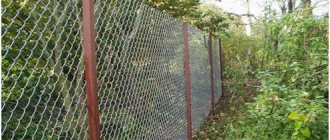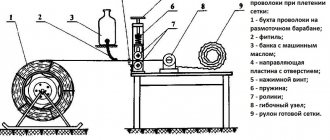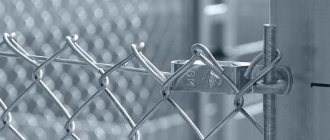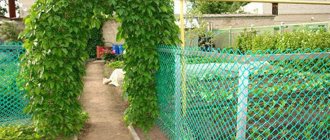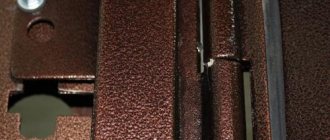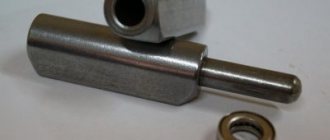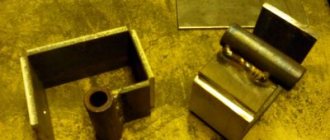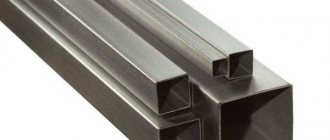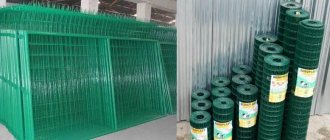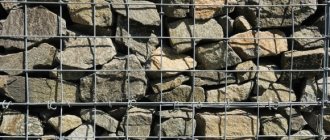Galvanized mesh for fences
Fences made from mesh are very popular; they are indispensable in cases where you need a reliable fence with good light transmission and a low price. In addition, modern fences made of welded galvanized mesh are very attractive, durable and easy to install with your own hands.
Classic country fence made of galvanized welded mesh
Benefits of mesh fences
Chain-link has a number of significant advantages that justify the decision in favor of choosing this product. Among the main advantages of this construction material it is worth highlighting:
- significantly lower financial and time costs for arranging a mesh fence compared to fences made of profiled sheets and wooden picket fences;
- low price of supporting elements for hanging mesh fabric and tensioning attributes;
- high strength compared to wooden barriers;
- ease of installation, allowing you to install a mesh fence with your own hands, easier than all other types of fence materials.
Self-tapping screws
Advantages of galvanized mesh
They produce galvanized mesh from metal wire. Its rods are arranged perpendicularly and are fastened at the connection points by welding. The cells of the welded mesh are made rectangular, square, less often diamond-shaped, trapezoidal or other shapes.
The wire for the mesh is galvanized or with an additional polymer coating. Fencing made of welded galvanized mesh has its advantages:
- Affordable price;
- Simple and quick installation of the mesh can be done with your own hands;
- Light weight, does not require foundation construction;
- Transparency and good visibility allow it to be used at protected sites;
Fence design made of galvanized mesh and metal corners
Application area
Installation of a fence made of welded mesh is often ordered for summer cottages and vegetable gardens, but such fencing has many more applications.
- Territory of public institutions. The list of such places includes kindergartens, schools, and parks.
- Sports grounds. Metal mesh is resistant to mechanical damage, so it is indispensable in areas for sports activities.
- Industrial enterprises and facilities. With the help of such a fence, you can block the entrance to the territory of gas stations, transformer substations, railway stations, electric and gas stations.
- Parking lots for vehicles.
- Fencing for forestry and agricultural land.
Types of welded mesh fences
Depending on the type of coating, welded mesh fencing is available in the following types:
- Non-galvanized mesh. The simplest version of a mesh welded from steel wire with a diameter of 1.2–10 mm. It has a low price and is susceptible to corrosion.
- This mesh will have to be painted periodically to improve its appearance and provide additional protection.
Rolls of non-galvanized mesh size 50x50 Also, galvanized mesh can be produced in the following types:
Drawing of a section of a fence made of galvanized mesh
- Galvanized mesh in rolls. The weight of the roll can be from 50 to 500 kg. The height of a fence made of rolled mesh is available up to two meters. The length of the mesh in the package can be from 15 to 33 m.
- Sectional (quick-release) fence mesh. Such a fence can be assembled very quickly with your own hands. The welded mesh is placed in a rectangular frame made of a profile pipe or angle. A fence made of sections is more durable and attractive. Sectional fencing is the most in demand both in urban environments and in the private sector.
- Decorative welded mesh 3D for fences. A new type of galvanized fence made of welded sections. How to attach a gate to a brick pillar? The design is made of curved rods that create a three-dimensional effect; it looks very unusual and beautiful. This version of the fence uses a PVC layer and decorative wavy sections along the edges or in the middle of the canvas. Another option is made in the form of twisted and corrugated wires.
Decorative fencing made of welded mesh can often be seen around city parks; it looks organic in combination with the vegetation around playgrounds and private cottages.
Return to contents
Attaching chain-link mesh to metal posts
Fastening the chain-link mesh to the corrugated pipe is carried out using self-tapping screws and a hook or with a welding machine. In any case, fence supports must be secured carefully. Since they play the role of a frame that allows you to connect all the component nodes with each other.
Drawing for installing a fence
Methods for manufacturing sections
A roll of mesh for the fence is laid out on the ground, measured approximately 2 meters and carefully cut with a grinder, taking into account the selected size. Next, reinforcement rods are installed in the outer rows of links. The metal rods do not need to be connected to each other.
You can also make a frame from a 40x40 mm corner and attach a chain-link to it. Welding will be required to make the frame. This method of fastening will be more expensive.
The photo shows a fence made of profile pipes at the dacha.
Metal fencing made of corrugated pipe
How to attach sections to corrugated pipe posts
The chain-link is laid out on the frame and welding is used to attach the upper part of the reinforcement to the inside of the corner. Then carefully straighten the mesh from below and weld the lower rods. Next, the side parts are installed.
Sketch for installation
The prepared structure is installed vertically to a column made of corrugated pipe and secured to steel plates or corners. You can also attach the fragment with screws by making a hole of the required size.
When installing the next element to the corrugated pipe, you need to make sure that the extreme sections of adjacent frames are in the same plane. Even a difference of a centimeter is noticeable; it will give the fence an untidy appearance. Finally, the mesh is primed and painted. In this way, interconnected sections can be easily installed to any length.
The photo below shows a fence at the dacha.
Sectional fence option
Fastening the chain-link to the pipe using the tension method
To ensure the rigidity of the mesh fence during attachment to the corrugated pipe, a cable with a cross-section of 5–7 mm is stretched from above. This is necessary to resist wind and prevent the chain-link from sagging. This structure can be attached to metal posts and tensioned in any way, but it is better to use special tensioners.
Fastening examples
When installing a fence made of chain-link and corrugated pipe and fastening it with guy wires, the distance between the supports can be made larger, up to 3 m. But it must be taken into account that during the tension process, the load on the metal posts, which are located at the edges, increases. It is necessary to increase their strength in contrast to posts with a regular fence.
How to choose a galvanized welded mesh fence
- The first thing you need to pay attention to is the wire thickness and dimensions. The larger the diameter of the rod and the smaller the mesh, the stiffer the structure of the galvanized fence will be. Such a fence will have a higher price, because more material is spent on the mesh;
- Choice of canvas sizes. Depending on the desired height of the fence, you can select a galvanized mesh from 0.5 to 2 m, the length of the mesh in a roll is from 15 to 33 m. Dimensions of the mesh fence section: height - 2 m, length - up to 2.5 m;
- The ends of the wire should have an even cut or bend. There should be no cracks or damage. A mesh produced in violation of technology is unlikely to last long;
- The cells must have the correct symmetrical shape, and the dimensions must correspond to the parameters declared by the manufacturer;
- Polymer-coated mesh should not have any damage to the protective layer; you should especially carefully inspect the bends if you purchase the mesh in a roll.
step-by-step instructions, photos and videos
When constructing a fence, it is not always possible to use materials that have a monolithic surface. This most often applies to situations where it is necessary to delineate adjacent garden plots in which various plants are grown. In this case, it is most advisable to build a fence from a welded mesh with your own hands. Such a structure will save the neighbor’s and your own territories from shading and will not interfere with the full development of plants, thereby causing discontent among people living in the neighborhood.
Material selection
First of all, you need to choose what type of material the welded mesh fence will be made from. There are four main options, which differ from each other in coating.
Uncoated mesh
It is usually sold in rolls and is cheap. Its use would be appropriate among bushes, since the surface of this fence will very quickly become covered with rust. Painting will be economically infeasible and labor-intensive. On the other hand, if there is dense vegetation at the border of the plots, and you need to protect yourself, mainly from migrating animals, then this option is quite acceptable.
Galvanized mesh
Perhaps the most practical material would be this kind of material. It is not much more expensive than the first one, and taking into account the total price of the entire structure, the difference will be about 10%. After all, the price of the structure includes pillars, hardware and components for concreting the supports.
Galvanized painted mesh
Its coating is applied according to the same principle as on corrugated sheeting. First, the product is galvanized, and the top is also painted. This is a very reliable coating. The only thing it is afraid of is abrasive effects. Rains and watering the garden lead to regular splashing of the soil-containing substance, which leads to the abrasion of the protective layer and subsequent corrosion. Therefore, it is recommended to attach such material slightly above the ground surface, and if it is necessary to seal the lower space, you can build a concrete or other base.
Polymer coated mesh
This type of protection is the most expensive, but also the most effective. It is resistant not only to temperature influences, but also to friction. In the most visible areas, it is worth using this option, since it has a beautiful appearance and will allow you to isolate the territory to the entire required height without additional costs.
In addition to the fact that the material differs in the type of coating, it can also differ in the method of execution, which can be:
- Welded flat mesh
- Welded mesh 3d for fence
The last name is produced by specialized enterprises, which, complete with this name, supply special poles and fastenings to create an aesthetic and reliable fence.
Preparation of tools and material for sampling
Once the welded mesh for the fence has been selected, you can begin preparatory work, one of the stages of which is equipping the work contractor with the necessary tools. This is an important stage, since the inability to carry out this or that operation will greatly slow down the construction, and the material prepared and laid out on the site will create interference. Therefore, it is best if all the necessary components have already been purchased and delivered to the construction site. Here's what you'll need:
Tools
Surely everyone assumes that you will definitely need basic tools, such as:
Digging tool
Any means for digging holes that are found on the farm will be suitable. The hole drill can be used either manual or electric. Of the shovels, the most convenient will be the “American” one, since it has a curved end, and this is very convenient when digging holes for posts.
Container for mixing the solution
- Concrete mixer (if available)
- Trough with hoe or shovel (optional)
Tools for installing mesh
- Welding machine (if fasteners will be used with it)
- Drill
- Screwdriver
- Screwdriver
- Bulgarian
- A piece of reinforcement or thin pipe for stretching the mesh
Materials
Let's figure out what materials will be needed to install a welded mesh fence and decide on their choice.
Pillars
It is best to use round or profile pipes with a diameter of 40-150 mm as pillars. The use of concrete or wooden supports is acceptable. In the latter case, it would be better to carry out protective treatment of the wood.
Cross bars
To create additional rigidity for the mesh covering, you can use thick wire threaded through the mesh. Also, spans can be attached to pipes or fittings attached between the pillars in the upper and lower parts. You don’t have to do this if the supports are often installed and the mesh has sufficient rigidity.
Wire can be used up to 5 mm. It is recommended to use fittings or pipes for rigid fastening from 10 mm.
Fasteners
To attach the mesh you can use:
- Bolt hooks (best option)
- Self-tapping screws
- Metal plates
- U-shaped clamps
- Brackets with bolts and nuts
Materials for concreting supports
- Water
- Cement
- Sand
- Rubble stone, slag or crushed stone
Fence installation
Like any other type of fencing, a metal fence made of welded mesh should be started in stages.
Site marking
With this procedure, it is necessary to take into account, first of all, the distance between future supports. It depends on their height, the thickness of the selected material, and the parameters of the material that will cover the spans.
The recommended distance in such cases is usually 2-3 meters. A more frequent arrangement of racks will entail additional consumption of material for them; a larger distance will require the use of transverse stiffeners, which will have to save the mesh from sagging. When marking, it is necessary to take into account the dimensions of rolls or finished sections of mesh, as well as the dimensions of the entire area. All these values must be compared and the distance between the supports must be planned so that the joints of the fence covering fall on the surface of the posts.
Installation of pillars
To do this, you need to dig or drill holes in the marking areas. The depth can be in the range of 0.7-1.2 meters. This depends on the size of the posts and the density of the soil. It is also worth considering the landscape of the earth's surface. On slopes, the depth of the holes needs to be greater. This is not only necessary because in such places the soil tends to slide, but also because streams of water flow along inclined surfaces when it rains. This leads to softening of the soil and a decrease in its ability to hold objects fixed in it.
After the pits are ready, prepared supports are installed in them and concreted. In this case, it is necessary to strengthen the installed racks with wedges in order to avoid tilting during the process of pouring and drying concrete.
Mesh installation
Installation is best done no less than 7-10 days after concreting the supports. It is during this time that the cement composition will gain the required installation strength. Although many craftsmen install the mesh the very next day, this is not the best option
If transverse pipes will be involved in the fastening, then you need to immediately weld them or attach them with self-tapping screws. It is better if these stiffeners are placed between the sides of the racks that face each other. With a carefully selected size of the jumpers, they will act as spacers and protect the supports from coming together under the influence of the tension of the mesh.
When used against sagging wire, it is threaded after hanging the mesh, but before tensioning.
The diagram below shows various options for attaching welded mesh with clamps
The mesh covering of the fence can be attached in several ways:
- Welding
- Using clamps
- By hanging on hooks
- Self-tapping screws and pressure plates
It is important that when attaching the mesh, it is tensioned in a timely manner. If the installation is carried out using hooks or self-tapping screws with plates, then first you just need to hang the material on them, and then tighten it evenly.
When welding fastening, the mesh must be tensioned immediately until final fastening. The material must be tensioned using a vertical pipe or fittings threaded through it, as discussed above. At least two people must participate in this process. One produces tension, while the other attaches the mesh to the post. The use of a vertical rigid rod is due to the need to produce uniform tension over the entire height, which will be very difficult to do by hand.
Now all that remains is to decide on the method of attaching the mesh and begin installation
Final actions
After hanging the mesh covering, you need to check the level of all racks, paint the fastening joints (if necessary), pillars, transverse pipes or tensioned wires.
Recommendations and conclusions
With proper preparation, a sectional fence made of welded mesh can be built by any home craftsman with minimal training. There are several recommendations that will help you get the best results:
- It is important at all stages to monitor the level of the installed posts and not to apply excessive force when tensioning the mesh.
- Before painting, any metal surfaces should be thoroughly cleaned with sandpaper, degreased with a solvent and primed. This will ensure the durability of the paint and save you from additional costs in the future.
- If it is planned to make a concrete plinth under the main fence, then it must be done together with concreting the pillars.
- When working with cutting and welding mechanisms, you should not forget about your own safety measures and use protective equipment and clothing.
Photos of welded fences
We have selected interesting photographs of welded mesh fences. Please note that the installation and assembly of this type of fence is quite simple and inexpensive. Therefore, this type of fence is more suitable for summer cottages
Installation video
This short video shows the complete welded mesh fence installation process. In this video, the 3D mesh is attached using a hook bolt. Please note, as mentioned above, that there are quite a lot of options for attaching the mesh and you just have to choose it
myfencing.ru
Features of installing a fence made of galvanized mesh
There are two ways to install galvanized mesh:
- Tension of the fabric between the pillars;
- Installation of sections.
The first option is cheaper and easier to do yourself. But the second option is considered more aesthetically pleasing and stronger.
If you do not purchase ready-made welded spans, you will have to make the sections yourself from angles or profiles.
Fence posts can be either wooden or metal. Of course, if you build thoroughly, you should use steel supports with a cross-section from 6 to 12 cm.
Tips for arranging a fence
The introduction of zinc-coated mesh does not require coating with paints and varnishes. But if the section is made by hand, the protective coating can be destroyed during welding. Then you need to provide additional protection with paints and varnishes.
The use of welded rolled mesh involves two solutions: cutting the material yourself to produce sections; installation of the fence sheet using clamps; however, there is no need to cut it.
If for the second option a zinc-coated mesh is used, then the installation process will take less time because there is no need to prepare sections. But in this case, the fence will lose its strength.
But the thicker the wire used in the production of the material, the stronger the system will be. The cell sizes of the rolled mesh are also responsible for this property.
Installation of pillars
- Perimeter marking. To ensure that the fence is level, the cord is pulled and the location of the posts is determined. The supports must be located at even intervals of at least 2.5 m.
- Installation of fence posts. Holes 120–150 cm deep are prepared for the pillars, the bottom of the wells is filled with crushed stone and sand 10–15 cm thick.
Each layer is moistened with water and compacted. The pole is installed in the hole, checked for verticality and supported. - Mixing mortar and concreting pillars. Concrete is poured into the well and carefully compacted with a crowbar or reinforcing rod. You can start installing sections and stretching the mesh no earlier than in a week, then the composition will be strong enough.
Return to contents
Installation procedure
We measure the perimeter of the area where the fence will be installed. Depending on the height of the future fence, we select a roll of the appropriate width. We install support pillars at a distance of no more than 2-2.5 m from each other. Remember that the wider the step between the supports, the greater the likelihood of sections sagging after repair.
Support posts must be protected from corrosion before they are installed in the ground or concrete.
To do this, it is necessary to apply a thick layer of paint, bitumen, or wrap it with a piece of roofing material on the lower part of the post.
Please note that all posts must be installed strictly vertically along the entire perimeter of the fenced area. To easily align the posts, use a tape measure, a building level and twine. You can also install crossbars made of boards or timber horizontally at the top and bottom of the fence, attaching them to the posts with screws or bolts. This will allow the pillars to be installed as level as possible.
Welded mesh for a fence is a frame made of metal corners to which the mesh is welded. You can make such a frame yourself or purchase a ready-made one at any hardware store. True, the second option will cost a little more .
Useful tips
When starting installation, you should take into account several tips from professional builders. This will help install the fence faster and better.
- When installing supports for welded mesh, do not choose wooden posts. Under the weight of the metal mesh, the fence may become deformed.
- If the choice is made in favor of a rolled chain-link, it should be deployed in advance (1-2 days before installation). In this case, the product will have time to rest, and there will be fewer errors in the work.
- It is better to carry out excavation work in the off-season (autumn or spring). At this time of year, the ground is more loose, so making holes will not be difficult.
- Experienced installers advise preparing a cement mortar designed for 1 hole. This will prevent the total mass from solidifying and will reduce the cost of constructing the fence.
